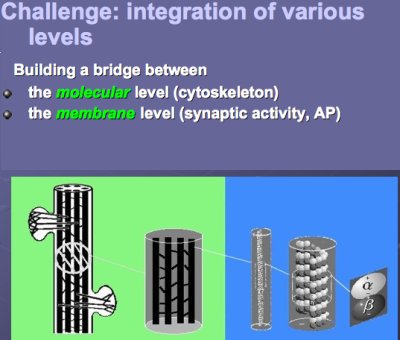The Dynamics of C-termini of Microtubules in Dendrites: A Possible Clue for the Role of Neural Cytoskeleton in the Functioning of the Brain
Jack Tuszynski, Ph.D.
page 3 of 5
This is an amazing journey that we can actually simulate it in the computer. We believe that simulations give us a glimpse into what may be happening at the scale of picoseconds to nanoseconds. Microtubules are very important; they can self-assemble. That is also a very interesting feature. Even in vitro in the lab, you can self-assemble them and create hybrid structures.
On the surface, motor proteins, kinesis, and dyneins are walking on microtubules, in effect, being guided. If you disrupt these microtubules, all traffic stops. It is not just incidental; it is absolutely necessary and essential for transport within the cells. One important transport element is mRNA going to synapses and building a neuro-transmitter. The neuro-transmitter is absolutely essential for cognitive functions.
In Image 3, we are zooming in. There is a microtubule taken by transmission electron microscopy computer, and this is a reconstructed surface of a microtubule. On the right, from the component tubulin protein, to give you dimensions, the last inside panel has a 25-nanometer diameter and a length of about 10 microns on average, 10 micrometers. The right hand side panel shows you a protein that is about 8 by 5 by 4 1⁄2 nanometers. Individual ribbons may have dimensions of several angstroms.

Image 3: Zooming In
Very briefly, microtubules are composed of tubulin and are very dynamic, so this is actually a mathematical simulation. We spent some time trying to simulate observations in the lab, which showed that microtubules grow and shrink in a kind of stochastic unpredictable manner. This is regulated inside the cells especially during cell division and dividing cells. Microtubules grow on demand. When they connect to chromosomes, they stop growing and start shrinking, segregating the chromosomes. This does not happen to neurons, of course, because neurons are not dividing. Yet during neuron growth, microtubules do grow to form the structure.
Microtubules do rearrange in the lifetime of a neuron. Thus it is not once and for all. The tubulin is being replenished and rearranged. I think this has to do with some possible malfunctions. One potential negative effect is when they lose binding ability with microtubule-associated proteins, you may end up with a neurological disorder such as Alzheimer’s. Microtubules are involved directly in Alzheimer’s and other neurological diseases.
We know quite a bit about what tubulins are composed of and I want to draw your attention to two aspects. The most successful chemotherapy drug on the market: Paclitaxel, with two billion dollars a year in revenue. We know exactly where and how it binds, and we know exactly what to do to make it bind better and more specifically.